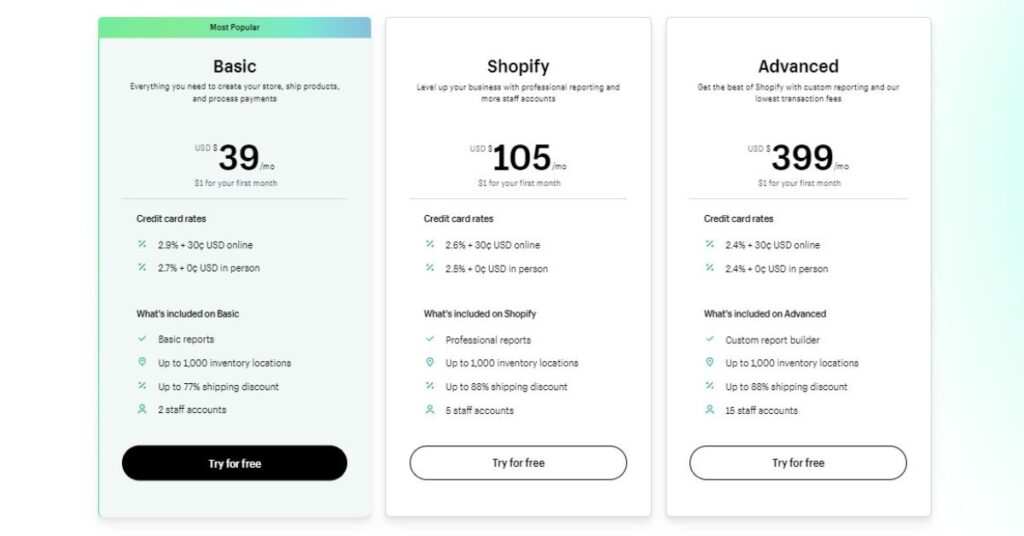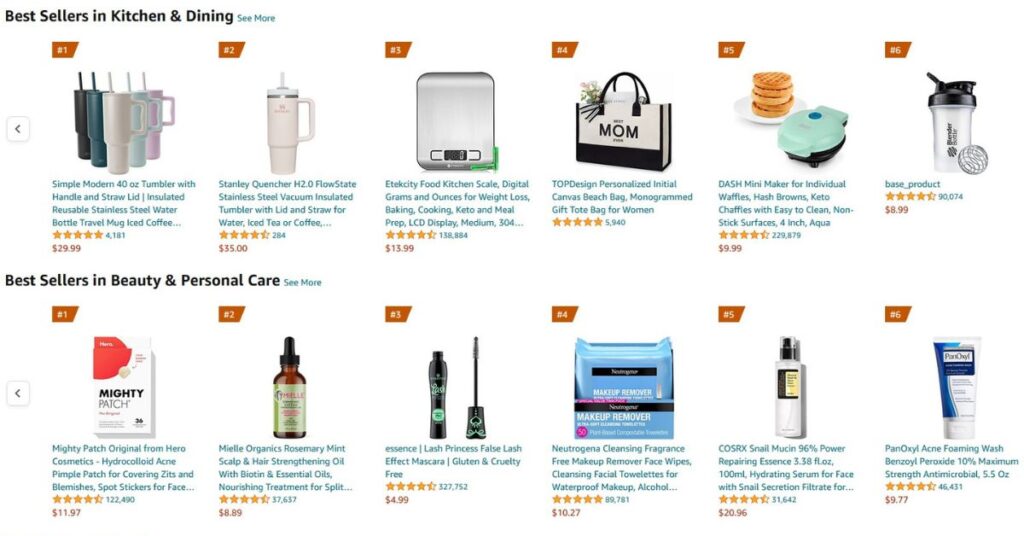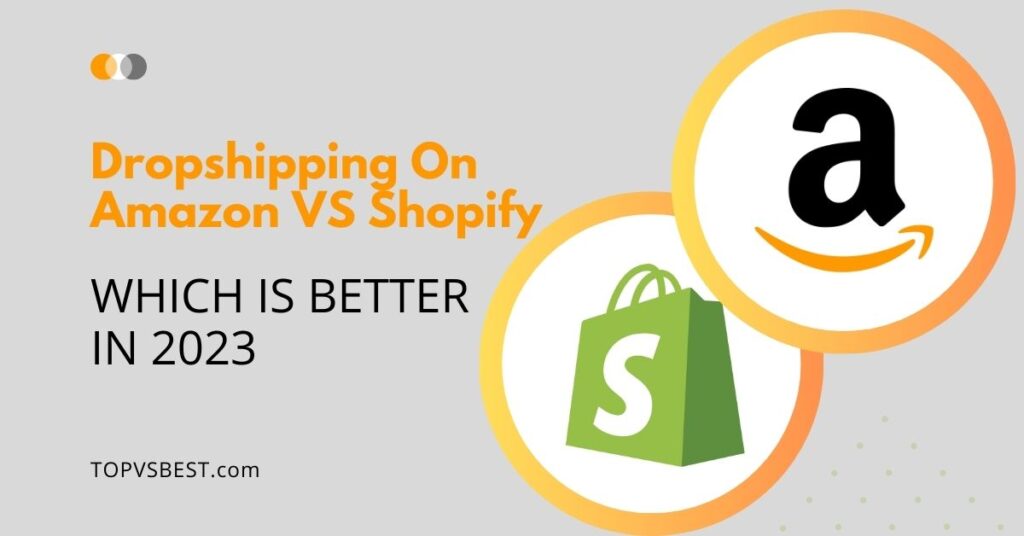Overview
Dropshipping has become a popular business model for entrepreneurs looking to start an online business with minimal investment.
Amazon and Shopify are two of the most popular dropshipping platforms, each offering unique advantages and disadvantages.
This blog post will compare dropshipping on Amazon vs. Shopify and discuss which platform is better for starting a successful dropshipping business. We will also explore legal and other considerations and factors when deciding between the two platforms.
Dropshipping On Amazon VS Shopify
Dropshipping is a type of online retailing where the seller can provide products to customers without the need to keep an inventory.
The products are delivered directly from the supplier or warehouse to the customer, meaning the seller doesn’t have to deal with the product physically.
Amazon Dropshipping
When it comes to dropshipping on Amazon, there are several policies to consider. Amazon allows dropshipping, but it has strict guidelines that sellers must follow.
For example, sellers must be the seller of record for the product and must take responsibility for customer service and returns. Additionally, sellers cannot use another retailer or marketplace to fulfill orders.
To calculate your Amazon Seller (FBA) fees and store profits, use our Free Amazon FBA Calculator.
Shopify Dropshipping
However, Shopify offers more freedom, customization options, and greater control over the branding and customer experience.
Regarding dropshipping capabilities, Amazon and Shopify offer similar features, such as the ability to fulfill orders and track inventory automatically.
For an in-depth guide on Shopify, read our What Is Shopify? A Beginner’s Guide 2023.
The Differences Between Shopify And Amazon
In terms of the key differences between Shopify and Amazon, the most significant difference is the type of audience each platform attracts.
Amazon’s audience is geared toward shopping for deals, while Shopify focuses more on unique products and brand experiences.
Another difference is the level of customization available. Shopify offers a more personalized and branded experience, while Amazon is more standardized.
Regarding fees, Shopify charges transaction and subscription fees, while Amazon charges fees for listing, selling, and fulfillment (if using FBA).
Choosing the right platform for dropshipping depends on various factors, including audience, product catalog, and cost.
Shopify and Amazon offer unique advantages and disadvantages for dropshipping businesses, and it’s essential to weigh these carefully before deciding.
Ultimately, the platform that best aligns with a business’s goals and target audience is the best choice for success.
Amazon VS Shopify Pricing

Amazon provides various seller programs, including Individual and Professional plans, and each comes with advantages and costs. The Individual Plan costs $0.99 per item, and the Professional Plan is $39.99 monthly.
Shopify provides different pricing plans to cater to businesses of various sizes, with the starting point being the Basic plan, which costs $39 monthly.
For more advanced features, Shopify offers higher-priced plans: the Shopify plan for $105 and the Professional for $399 monthly.
Paying by the year is 25 percent cheaper. The different pricing plans offer varying advantages, including lower transaction fees and more comprehensive reporting and analytics.
Shopify VS Amazon VS Etsy
Shopify, Amazon, and Etsy (we include Etsy here as well) are three of the most popular platforms for dropshipping. Choosing the right platform is crucial for success when it comes to dropshipping. Below we analyze some important metrics of each.
Market Share
Regarding the market share of these companies, Amazon is the largest, followed by Shopify and then Etsy. Amazon’s revenue is also significantly higher than that of Shopify and Etsy combined.
However, Etsy has a more niche audience, which could benefit certain dropshipping businesses.
Features
In terms of features, Shopify and Amazon both offer a range of tools and integrations to help streamline the dropshipping process.
Shopify is known for its user-friendly interface and extensive customization options. Plus, the freedom to choose suppliers.
Amazon, on the other hand, offers a massive product catalog and a vast customer base.
Etsy is unique in that it focuses on handmade and vintage items, which could appeal to businesses in that niche.
Advantages And Disadvantages Of Each
When it comes to the advantages and disadvantages of each platform for dropshipping, there are several factors to consider.
Shopify’s customizability and ease of use make it an attractive option for beginners. However, building a customer base can be challenging.
Amazon’s massive product catalog and built-in audience make it an excellent platform for businesses looking to scale quickly. However, the competition can be fierce.
Etsy’s niche audience and focus on handmade and vintage items could benefit businesses in that market. However, there may be better fits for firms selling mass products.
Why People Choose Amazon Over Shopify

First, Amazon offers access to a massive customer base and streamlined operations through its Fulfillment By Amazon (FBA) service. However, customization options are limited, and competition can be fierce on the platform.
When choosing between Amazon and Shopify, there are pros and cons. Here are some advantages of selling on Amazon:
Pros:
- Massive customer base: With hundreds of millions of monthly visitors, Amazon provides a vast market for sellers
- Seller Central Portal functionality: Amazon provides a comprehensive Seller portal that includes features for managing product catalogs, pricing, shipping rules, inventory, and analyzing business operations, among other features.
- Streamlined operations: Amazon’s Fulfillment By Amazon (FBA) service allows sellers to store their products in Amazon’s inventory, meaning that they don’t have to handle order fulfillment themselves, making operations easier.
However, there are also some disadvantages to selling on Amazon:
Cons:
- Intense competition: As many sellers offer similar products, it can be challenging to stand out from the Amazon crowd, providing very limited room for customization.
- Restrictions on payment methods: Amazon Pay only accepts credit/debit cards or a balance in your Amazon Pay account.
Despite these challenges, Amazon remains an attractive option for many sellers due to its massive audience and efficient operational processes.
Some sellers use both Amazon and Shopify to take advantage of both platforms. Shopify is a better option for creating an independent online store with total control and for starting a dropshipping business.
Why People Choose Shopify Over Amazon
When it comes to dropshipping, some people prefer Shopify over Amazon for various reasons.
One of the main advantages of using Shopify is the ability to create a more personalized and branded shopping experience.
Shopify’s customizable themes and apps allow sellers to build a unique online store that reflects their brand.
Additionally, Shopify offers many payment options and greater control over supplier choice and pricing, which can be attractive to some sellers.
Discussions on Reddit and other forums reveal that many users prefer Shopify for its simplicity and ease of use compared to Amazon’s more complex and bureaucratic system. Others express concerns about the competition on Amazon and the potential for their products to get lost in the crowd.
Let’s break down the pros and cons of using Shopify over Amazon:
Pros:
- Ease of use: Shopify’s templates and drag-and-drop features make it easy for merchants to build an online store quickly and without much technical knowledge.
- eCommerce tools and apps: Shopify offers a wide range of tools and apps to help merchants streamline their operations, from inventory management to shipping.
- Payment options: Shopify offers a more significant number of payment options.
Cons:
- Building a reputation and driving traffic: Since merchants are responsible for marketing their stores, building a reputation and driving traffic to their Shopify site can be challenging.
- Limited customization compared to other platforms: Although Shopify offers customizable templates, it is less customizable than some open-source platforms (like Woocommerce used by Bluehost), which may limit a merchant’s ability to tailor their site to their specific needs.
Choosing Shopify or Amazon will depend on a business’s specific goals and needs. While Shopify may be easier to use and offer more payment options, Amazon’s larger audience and Fulfillment By Amazon service may make it a better fit for some businesses.
Is It Possible To Sell On Both Amazon And Shopify At The Same Time?
Absolutely! Having all your eggs in one basket is never a good idea. You can join millions of merchants who are selling on both platforms simultaneously.
Linking your Shopify account to Amazon is a very straightforward process. Many apps in the Shopify App Store can help you do just that.
By selling on both platforms, you can tap into the large and established market of Amazon while also enjoying the benefits of having your own fully-branded and independent online store on Shopify.
For more on how to link your Shopify and Amazon accounts, read our Dropshipping On Amazon: Best Guide For 2023 And Beyond.
Is It Legal To Dropship From Amazon To Shopify?
It is legal, and millions are doing it. But when dropshipping from Amazon to Shopify, it’s essential to be aware of legal considerations. One potential issue is trademark infringement.
Sellers must ensure they have the legal right to sell a product and avoid using copyrighted material without permission.
Additionally, sellers must comply with Amazon’s policies on dropshipping and avoid violating any intellectual property rights. It’s important to do thorough research and work with reputable suppliers to avoid potential risks.
Should I Start With Shopify Or Amazon?
What We Recommend
If you’re planning to start a dropshipping business, we recommend starting with Shopify and then expanding to Amazon with the help of its Fulfillment by Amazon (FBA) service.
(And if you use a local, reliable supplier or warehouse with fast shipping times, you can skip the FBA.)
Starting with Shopify allows you to experiment and improve your product offerings, marketing strategies, and customer service procedures in a low-risk environment.
Once you’ve established a successful dropshipping business on Shopify, you can move on to Amazon and take advantage of its extensive customer base and FBA service.
By using FBA, you can take advantage of Amazon’s fulfillment and shipping capabilities, freeing up your time to focus on growing your business. Selling on multiple platforms can also help you diversify your revenue streams and increase your overall sales volume.
Other Factors To Consider
When deciding whether to start with Shopify or Amazon for dropshipping, there are several factors to consider. One key factor is the target audience.
Amazon has a massive audience and an extensive product catalog, which can appeal to businesses targeting a broad audience.
However, Shopify offers greater control over branding and customer experience, which can be valuable for businesses targeting a more niche audience.
Another factor to consider is budget. Shopify can be more expensive for beginners than Amazon, who use Amazon’s “Per-Item” Plan.
However, Shopify’s customizable themes and apps can be valuable for businesses looking to create a unique online store.
Ultimately, the decision between Shopify and Amazon depends on the individual’s goals and circumstances.
Businesses targeting a broad audience can take advantage of Amazon’s marketplace.
However, for businesses looking to create a unique brand experience and target a more niche audience, Shopify may be the better option.
Conclusion
In conclusion, both Amazon and Shopify offer a range of benefits for dropshipping businesses. Amazon provides access to a large customer base and an extensive range of products, while Shopify offers greater customization and flexibility.
Ultimately, the choice between the two platforms depends on the individual’s goals, budget, and preferences.
We recommend conducting thorough research and considering all factors before deciding on a platform for your dropshipping business. With the right strategy and execution, either Amazon or Shopify can be a lucrative platform for starting a successful dropshipping business.



